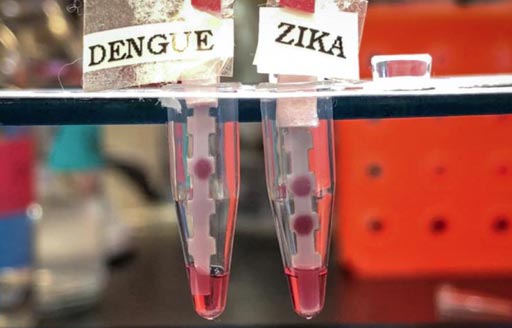Paper-based Immunoassay Distinguishes Zika and Dengue Infections
By LabMedica International staff writers
Posted on 10 Oct 2017
A rapid, easy-to-use immunoassay identifies individuals with Zika virus infection with no false positive results due to dengue virus or other flaviviruses.Posted on 10 Oct 2017
The recent Zika virus (ZIKV) outbreak demonstrated that cost-effective clinical diagnostics are urgently needed to detect and distinguish viral infections to improve patient care. Unlike dengue virus (DENV), ZIKV infections during pregnancy correlate with severe birth defects, including microcephaly and neurological disorders. Because ZIKV and DENV are related flaviviruses, their homologous proteins and nucleic acids can cause cross-reactions and false-positive results in molecular, antigenic, and serologic diagnostics.

Image: A new paper-based immunoassay rapidly distinguishes between Zika and dengue virus infections (Photo courtesy of the Massachusetts Institute of Technology).
In developing an assay capable of distinguishing ZIKV infection from DENV or other flaviviruses, investigators at the Massachusetts Institute of Technology (Cambridge, MA, USA) developed monoclonal antibodies to specific for viral nonstructural 1 (NS1) protein antigens characteristic for dengue and Zika.
Various monoclonal antibody pairs were integrated into rapid, paper-based immunochromatography tests to specifically detect the viral NS1 protein antigen and distinguish four DENV serotypes (DENV1–4) and ZIKV without cross-reaction. To complement visual test analysis and remove user subjectivity in reading test results, the investigators used image processing and data analysis for data capture and test result quantification.
The investigators reported that serum ZIKV NS1 protein concentrations were about 10-fold lower than corresponding DENV NS1 concentrations in infected patients; moreover, ZIKV NS1 protein was not detected in polymerase chain reaction–positive patient urine samples. Using a 30-microliter serum sample, the sensitivity and specificity values of the DENV1–4 tests and the pan-DENV test ranged from 0.76 to 1.00. Sensitivity/specificity for the ZIKV rapid test was 0.81/0.86, respectively, using serum samples of 150 microliters.
The assay successfully identified the four dengue serotypes and Zika viral infections without cross-reaction when tested against human serum samples from endemic areas in Central and South America and India.
"When we have traveled to the places where these viruses are problems, the people there unanimously say that they need more surveillance. They need to know which viruses are circulating in their environments," said senior author Dr. Lee Gehrke, professor in of microbiology and immunobiology at the Massachusetts Institute of Technology. "By already screening this group of antibodies that we have against all these antigens we have, like West Nile, we already know how well they react. So that is information we could use in the future to develop additional tests that can be used to detect other emerging viruses."
The Zika virus immunoassay was described in the September 27, 2017, online edition of the journal Science Translational Medicine.
Related Links:
Massachusetts Institute of Technology














